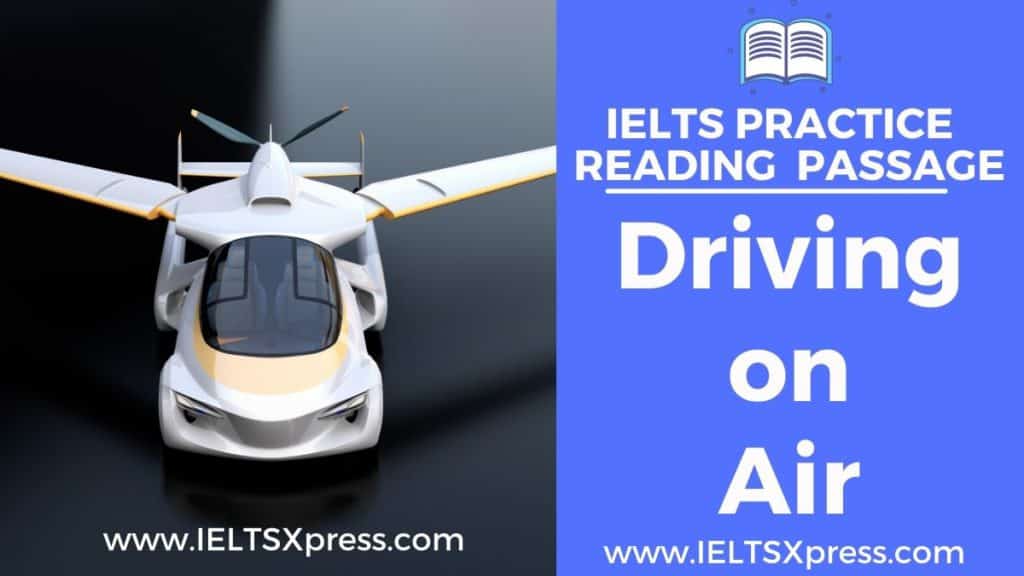Driving On Air IELTS Reading Passage with Answers
Reading Passage 1
You should spend about 20 minutes on Questions 1-13 which are based on Reading Passage 1 below.
Driving On Air
No matter how costly, hazardous, or polluting they are, nor how tedious it is to be stuck in traffic jams, cars are here to stay. In fact, the global car industry is worth a massive two trillion dollars a year.
Recently, Guy Negre, a French engineer on Renault’s Formula One engines, designed and produced the Airpod – a vehicle which runs on air, is lightweight and compact and capable of reaching moderate speeds.
Since the transport sector constitutes one-seventh of all air pollution, Negre spent 15 years developing the Airpod, hoping to significantly reduce greenhouse gas emissions. Petrol-electric hybrids, already on the market, are touted as being environmentally friendly, yet he says they are barely less polluting than combustion-engine vehicles. The Airpod, on the other hand, produces just 10% of the carbon monoxide of other cars.
Major manufacturers are now considering hydrogen as a power source for vehicles, but this technology may be decades away. Meantime, according to Negre, electric vehicles remain impractical: batteries are expensive, and need replacement within five years; recharging takes several hours.
Negre’s secondary aim in creating the Airpod was to bring cars within reach of consumers in the developing world. To date, his most impressive deal has been with an Indian car manufacturer which predicts the Airpod will retail for the price of an average motorcycle.
Currently, only three-wheeled Airpods are available, but Negre has a four-wheeled, five-door family saloon, plus vans, buses, taxis, boats, and aircraft on the drawing board.
So what is an Airpod? This small vehicle resembles an ordinary car except that it is made mostly from fiberglass – ten times as strong as steel but very light – meaning an Airpod weighs just 220 kilograms (484 lb). It has glass windows and an aluminium engine. However, it uses a joystick instead of a steering wheel, and it has backward-facing passenger seats and a front-opening door.
The 180cc engine of an Airpod allows it to reach a speed of around 70 kilometres per hour (kph) (43 mph), and it can drive for about 220 kilometres (137 miles) before refilling is necessary. It takes as little as 90 seconds to pump air into an Airpod from a high-speed compressor at a gas station, with air costing a mere 50 cents for a 220-kilometre journey. An on-board pump can refill the tank at home overnight.
How does an Airpod work? Quite simply: air is released through pistons in the engine, which drive the wheels. Compressed air tanks store up to 175 litres (46 gallons) of air at about 180 times the pressure of an average car tyre. Passengers and passers-by might have concerns about explosions with such pressure, but, in the rare event of one, the thermoplastic tanks split to release air, rather than shattering and exploding. In fact, the same tanks are already installed on natural-gas buses.
For longer journeys, there is a battery-assisted hybrid Airpod, which Negre maintains is capable of reaching 80 kph (50 mph) and travelling around 1500 kilometres (930 miles) on four litres of petrol, although this version has yet to be manufactured or tested.
Still, in its infancy, the Airpod has both supporters and critics. Marcus Waardenberg, the organiser of an Airpod trial at a major Dutch airport, was impressed. ‘The Airpods went over 40 kph (25 mph), were quiet and manoeuvrable. Refilling was fast and straightforward.’ As a result, his company is replacing its fleet of electric service vehicles with Airpods.
Perhaps more significantly, AK Jagadeesh, from the Indian conglomerate, Tata, signed a $60-million deal. ‘We’re going to use Airpod technology in Tata’s Nano car,’ he said.
Ulf Bossel, a sustainable energy consultant, commented that the Airpod easily reaches speeds of over 50 kph (31 mph). ‘Initially, it could capture the second-car market. Then, there are those older people who can no longer afford conventional cars.’ Both Europe and North America have ageing populations.
Bill Robertson, a motoring journalist, noted that the Airpod would suit large numbers of people who make two or three trips a day of fewer than ten kilometers, or who live in distant suburbs of big cities where public transport is poor. If the Airpod looked a little sexier, there would be the potential for it to make inroads into the golf buggy sector, which currently uses electric vehicles.
Among the detractors of the Airpod is the former champion racer, Martella Valentina, who would prefer a vehicle with a more robust engine. ‘There are so many aggressive drivers out there,’ she said. ‘As a woman, I don’t feel safe in an Airpod.’ She added, ‘Refilling overnight is a drag.’
The automotive engineer, Hamid Khan, concurs, expressing skepticism about sufficient energy storage under reasonable pressure to drive the car any distance, let alone the alleged 220 kilometres (135 miles) before refill. He insists this is unconfirmed by independent tests. Stopping and starting in typical city conditions would also lower the range even further, and more distressingly, safety data are lacking for crash testing. ‘Negre claims fibreglass is stronger than steel, but the Airpod looks as though it would crumble under the wheels of a normal saloon,’ commented Khan.
Nevertheless, Negre has signed deals to manufacture his car in the US, Latin America, India, and several European countries. Compressed air may no longer take a back seat to other power sources, and it is even conceivable that one day we may be flying in aircraft that fly on air.
Questions 1-8
Complete the summary using the list of words, A-O, below:
Write the correct letter, A-O, in boxes 1-8 on your answer sheet.
The 1 _____________ of combustion-engine cars continues 2 _____________ there being problems with them. According to Negre, an automotive engineer and inventor, a(n) 3 _____________ , the petrol-electric car, is really not much less 4 __________ . Negre believes his Airpod is far cleaner and cheaper, and will 5 _____________ drivers in the developing world in particular.
An Airpod is lighter than other cars at only 6 _____________ kilograms. The highest confirmed speed it can reach is around 7 _____________ kph. It can be refilled fast at a service station or more slowly at home. Some people may be worried about the high-pressure gas stored onboard an Airpod, but its tanks are safe and already in 8 _____________ on public buses.
| A exist | B popular |
| C polluting | D 80 |
| E benefit | F although |
| G70 | H polluted |
| I alternate | J alternative |
| K 220 | L use |
| M popularity | N 180 |
| O despite |
Questions 9-13
Look at the following statements and the list of people below.
Match each statement with the correct person: A, B, C, or D.
Write the correct letter, A, B, C, or D, in boxes 9-13 on your answer sheet.
9 He claims the hybrid Airpod can travel 1500 kilometres on four litres of petrol.
10 He imagines the Airpod will appeal to the elderly.
11 He doesn’t think the Airpod will compete with golf buggies unless it changes its appearance.
12 He doesn’t believe the Airpod can drive as far as its creator maintains.
13 He has agreed to the manufacture of the Airpod in a number of countries.
List of people
A Bill Robertson
B Guy Negre
C Hamid Khan
D Ulf Bossel
Driving On Air IELTS Reading Passage Answers
Practice with Expert IELTS Tutors Online
Apply Code "IELTSXPRESS20" To Get 20% off on IELTS Mock Test
1. M
2. O
3. J
4. C
5. E
6. K
7. G
8. L
9. B
10. D
11. A
12. C
13. B
Also Check: Follow Your Nose IELTS Reading Passage Answers



